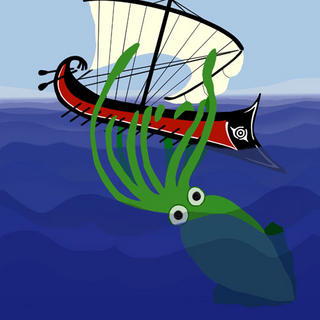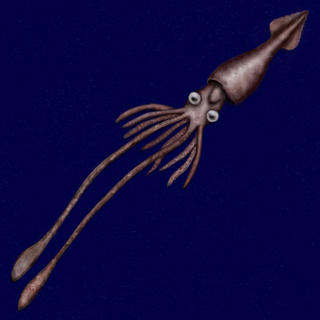Depths mades me think of being far from civilisation, exploring and boundaries -as we say we are in the depths of the dark forest, depths of the canes in the earth, depths of the oceans.
It also brings to mind cryptozoology - the study of creatures whose existence has not been confirmed - the yeti, sasquatch, Nessie, Megalodon [giant white shark] and other creatures who may live deep in the woods or in the deepest lochs or seas.
I thought at first i would draw Nessie since Loch Ness has a depth of at least 740ft with an average depth of 600ft over its twenty three miles of length. Loch Ness is fascinating for a variety of reasons and not just the fabled monster. The water is rich in peat which makes the water brown and visibility very poor.
It is the deepest body of fresh water in the Britain and apparently never freezes over, even in the coldest winters, as it maintains a constant temperature of about 5degrees C.
Water beasts have been seen in Loch Ness since the times of Saint Columba and they were inititially said to be Kelpies -which are often seen in the guise of magical horses- with the unfortunate tendency of drowning anyone who tried to ride them.
After Nessie i thought about Tethys, the primeval ocean from both science and mythology . When the land was massed as one continent Pangeae and later as it broke into continents , the Tethys Ocean or Sea surrounded the land and became the habitat of some of the most bizare and enormous animals ever seen on earth.
[Mythological note: Tethys Greek Goddess of underground water and nursing mothers; later seen as the sea personified and equated with Eurynome the fish tailed Goddess of the Titans]
Tethys of course made me think of the deep sea and it was only a short way from there to the Kraken. A beast now thought to be on the boundary of cryptozoology and conventional science; the giant squid.
The Kraken is described as a giant beast as large as islands that trapped unwary vessels by wrapping it huge arms around the hull and dragging the ship down in order to feast on the crew at its leisure.
Similar beasts turn up in the writings of Pliny the Elder and it has also been suggested that the beast Scylla from the Odyssey is a giant squid.
Squid are much more agreessive than octopus and it is known that giant squid fight with sperm whales as circular scarring has been found marking the whale's flesh showing the cutting power of the sharp chitinous rings found in the qiant squid's tentacles.
No scientist has ever seen a fullgrown giant squid alive and swimming freely as they live at tremendous depths , although they have been washed up in many areas of the world as far apart as Scotland and New Zealand.
Some have been caught by trawlers but they are often very battered by the time they are pulled aboard. There is scientific interest in raising giant squid in captivity to try and find out more about their lifestyle, but so far they seem elusive.
Giant squid [Architeutis dux ] have ten arms like all squid but two are extremely long and its postulated that these are used to grab their prey in an a way similar to the tongue of a chameleon - except the giant squid have spikes and suckers on these legs that hook into the flesh so that the prey can be grabbed by the shorter arms and held near the very sharp and tough beak for eating.
Giant squid have the biggest eyes found on living animals, they are as big as dinner plates and have a tendency to give them a more friendly appearance as humans see large eyes as a childlike characteristic.
Recently a French racing yacht was grabbed by a giant squid and its thouight that the squid may mistake the hull of a boat for the bodies of whales. Very reminiscent of the ancient tales of ships, which were probably around the same length as a racing yacht, being pulled under.
There have also been reports of survivors of ship wrecks in WW2 being picked off by giant squid while they waited for rescue. So a fearsome beast indeed.
There are a variety of historical descriptions of potential giant squid here
In the first painting i have taken liberties with the ancient Greek galley and the legend of Scylla - i've made scylla a giant squid. I wanted to have a very stylised portrayal of both ship and squid and i'm pleased with how they have turned out.
The eye painted on the boat is still commonly found in Greece and malta and other mediterranean coastal towns where the eye is painted to ward off evil.

This more realistic version of a giant squid is based on looking at a lot of indistinct photos of very battered dead giant squid , descriptions and calculated guesswork. Giant squid are probably able to change colour and produce sepia [squid ink] and its likely that female giant squid are larger than the males, males probably live longer though. Dead giant squid seem to be whitish with reddish brown areas but that is probbaly not their usual coulour when they are alive.
I actually came across this page while writing this blog entry and it turns out the photo of the squid being examined and prepared for display here is considerably better than any of the others i found.
However, as yet there are no films or photos of the giant squid in their natural habitat.

Update: 27th September 2005
Japanese Zoologists have apparently captured a live giant squid on film for the first time ever - the film was made 09:15 on September 30 2004 and the results have been published now in the British scientific publication; Proceedings of the Royal Society B by Tsunemi Kubodera of the National Science Museum in Tokyo and Kyoichi Mori of the Ogasawara Whale Watching Association.
As yet i can only see online news articles here and here and not the actual reference in the journal itself.
Update 28th September - National Geographic article here
photos of the giant squid are now on the National Geographic website here
A tentacle that was broken off the squid is here
kraken
squid
cryptozoology
giant squid
illustration
illustration friday
mythology




12 comments:
Nice illustrations, especially the 'lifelike' squid. I like squid to eat, but I also think them fascinating creatures.
Nice illo and full documented !
I love the strong graphic qualities of the first one. Nice compostition. Amazing research, too.
Alison, amazing research you have done again,
and great illustrations.
Alison, you've done really well with this topic! An excellent interpretation of the Scylla legend and terrific pic! Me, I've struck out entirely thus far...
Anyway, if you're into crytozoology and haven't already read them, I thoroughly recommend Bernard Heuvelmans' On the Track of Unknown Animals and Dr. Karl Shuker's The Lost Ark. I've got a post on my blog about two "new" animals discovered this year and one rediscovered bird!
I like the top picture best - it looks like an illustration from a mythology book, and in a sense it is. The colors are so bright and true, and it tells the story well. I know I've said this before, but I really enjoy the knowledge I gain from your well-researched discussions of your topic. It makes your already wonderful illustrations a complete experience :>
"No scientist has ever seen a fullgrown giant squid alive and swimming freely"
I think that's amazing. Who knows what other giant creatures could be hiding down there.
Nice work with this topic! I really like your style.
The idea of depth IS sort of creepy isn't it? Your squid is convincing. I'd rather not think of what else is 'down there' that hasn't been seen.
love the simple graphic smooth lines for the boat, and wonderful squid.
great illustrations. I find squid so interesting and commend you for the research you put into this submission.
Amazing research!
And great reading. I really like the first one.
In Spain squids are called "calamar", here is some info you'd like:
(Sometimes dead squids appear in our beachs)
http://www.bornet.es/notic/Medio_Ambiente_y_Conservacion/020603233633.shtml
Post a Comment